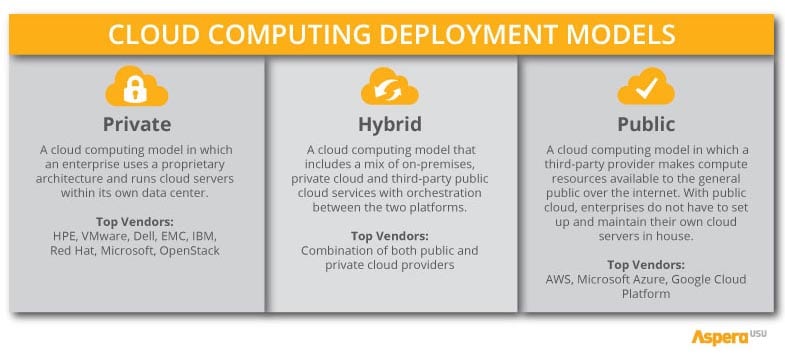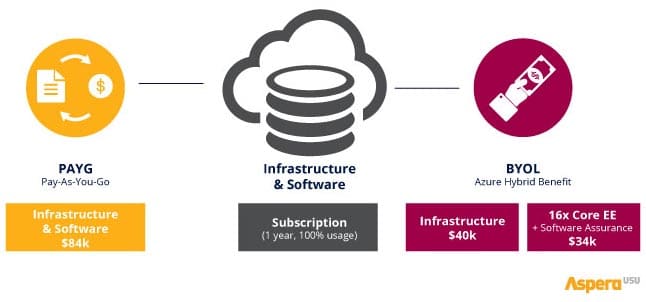
How to Build a Savings Pipeline for SaaS Renewals
Table of Contents ToggleWhat Is a SaaS Savings Pipeline?Why Managing SaaS...
Back
Back
Search for Keywords...
Blog

Table of Contents
Cloud adoption is racing forward at lightning speed. The global hybrid cloud market is expected to reach $138 billion by 2023. And research shows that cloud cost management as part of a comprehensive software asset management initiative in this hybrid cloud world needs to be a key focus for IT leaders.
In the 2019 Gartner report, Software Asset Management for the Cloud: Consumption Management and Optimization Take Center Stage, Gartner analysts explain that “Digital initiatives are fueling cloud service adoption, making their metering, management and optimization an inescapable need.”
So, if you work in IT, chances are that you’re talking about cloud computing – and more specifically, hybrid cloud. However, the definition of hybrid cloud can vary as much as the conversations you might be having.
It’s a confusing term that can hold various meanings depending on whether you’re talking about data centers or user-based software installations.
Gartner defines hybrid cloud computing as “policy-based and coordinated service provisioning, use, and management across a mixture of internal and external cloud services.” In this instance, Gartner is speaking to how hybrid cloud works in a data center environment and the coordination between what you have on-premises vs. what you have in the cloud.
A standard user example would be Office 365. In this case, when you buy a subscription to Office 365 you may have some applications or services that are just web-based tools like Teams or Yammer. But there are also subscriptions like E3 and E5 which are more common for business. These allow you to access applications via a web-based platform and let you install them on-premises on your desktop as well. This is a hybrid cloud scenario.
For this discussion, let’s define hybrid cloud as a cloud computing environment that uses a mix of on-premises, private cloud, and third-party public cloud services. The key challenge for cloud cost management in the hybrid cloud is that you need to understand your usage and compliance in both environments so that you only pay for the software that you need.

The key takeaway here is that licensing rules and product use rights differ depending on if you’re talking about public cloud, private cloud or on-premises licensing environments. This means that your biggest cloud cost management challenge is managing your costs in every environment. To identify cost-savings using cloud cost optimization, IT leaders need a complete view of both IaaS, PaaS and SaaS environments.
Take this real-life example for Azure SQL server. You’ve got two different licensing options here: Pay-As-You-Go (PAYG) and Bring Your Own License (BYOL).
If you choose PAYG, a one-year subscription covering 100% of usage would cost $84,000 for infrastructure and software. But by using licensing that you already own for your on-premises environment and applying it to the cloud, there is a hidden BYOL hybrid use benefit that delivers $10,000 in cost savings.

Most of us already reside in a hybrid-cloud world – licensing a mix of both on-premises, and cloud-based services. We know the cloud market is expanding. Gartner research shows that “By 2022, cloud shift across key enterprise IT markets will increase to 28 percent”. Yet some vendors are slow to abandon all traditional licensing, and most organizations are not positioned to operate 100% in a cloud-based environment.
Keep in mind that software vendors are also racing to keep up with cloud conversion. With the shift to the cloud, we’ve already witnessed a shift in how vendors approach software license audits. Since cloud service fees (such as SaaS) may dilute their revenue and reduce short-term profits, you can expect software license audits to escalate as vendors try to push contracts into the cloud or generate lost sales revenue.
With a strong cloud software asset management process, you can capitalize on the pressure vendors have to move you to the cloud. If you come prepared to bargain, the audit process can be potentially beneficial for your company’s bottom line.
Here are two strategies to drive cloud cost management in the hybrid cloud:
A common industry myth is that compliance risk will be lower as cloud adoption increases. However, Gartner research shows that as SaaS becomes more widely spread, compliance metrics will shift from a simple count-based system (per CPU, per core, per install) to a more complex consumption-based system (per CPU hour, per authorized user at a specific point in time).
So how do changes in compliance metrics impact your risk? Consumption-driven metrics can carry serious additional financial risks of unplanned costs, particularly when more hours than anticipated are used. An effective solution is to implement consumption-based analytics into your SAM architecture to prevent unplanned costs and business interruption.
In addition to a metrics shift, there are several other areas that cloud exposes for increased compliance risk within your organization. By defining comprehensive methods to defend yourself against these high-risk areas, you can further cloud-proof your software asset management foundation:
It’s no secret that the backbone of any successful Software Asset Management program depends on multiple accurate and up-to-date data sources for your software inventory. But cloud services may directly challenge the capabilities of your current discovery tools.
As your SAM environment fluctuates with new cloud adoption and implementation, discovery tools quickly become obsolete. In a 2016 report, Gartner asserted that by 2019, existing discovery tools will be useless for 90% of SAM needs.
For example, a tool that works in your physical Windows environment won’t be the same tool that works on mobile or cloud environments. You can mitigate unmanaged risk by augmenting your SAM architecture with additional data sources and cloud cost management tools that reflect current shifts in licensing models.
Another challenge is simply being able to manage the vast deployment of cloud services. Prioritize staying on top of potentially untracked services. Vigilant oversight is crucial as cloud expands at faster rates and unmanaged assets often lead to an increase in audit activity. Many vendors are still focused on pushing you into the cloud, and have yet to begin the next inevitable wave of audit activity. Capitalize on this time to get your systems in order, and monitor shifts in license models.
Keep your head out of the clouds and one foot on the ground as cloud adoption grows. Your organization can stay a step ahead by making sure that your Software Asset Management program is razor focused on cloud challenges. By thinking strategically about cloud cost management, you’ll be prepared making cost-saving decisions in upcoming contract negotiations.
Most importantly, be strategic! Software vendors are desperate for cloud revenue right now. Be savvy and use this to your advantage. Ensure that your Software Asset Management program stays dynamic and evolving as you rise above the cloud.

Table of Contents ToggleWhat Is a SaaS Savings Pipeline?Why Managing SaaS...

Table of Contents ToggleWhat FinOps Means in the Modern Cloud EnvironmentWhy...

Table of Contents ToggleWhat is Hybrid Cloud?Hybrid Cloud: Public, Private, and...

Table of Contents ToggleWhat is Hybrid Cloud?Hybrid Cloud: Public, Private, and...
| Cookie | Duration | Description |
|---|---|---|
| cookielawinfo-checkbox-analytics | 11 months | This cookie is set by GDPR Cookie Consent plugin. The cookie is used to store the user consent for the cookies in the category "Analytics". |
| cookielawinfo-checkbox-functional | 11 months | The cookie is set by GDPR cookie consent to record the user consent for the cookies in the category "Functional". |
| cookielawinfo-checkbox-necessary | 11 months | This cookie is set by GDPR Cookie Consent plugin. The cookies is used to store the user consent for the cookies in the category "Necessary". |
| cookielawinfo-checkbox-others | 11 months | This cookie is set by GDPR Cookie Consent plugin. The cookie is used to store the user consent for the cookies in the category "Other. |
| cookielawinfo-checkbox-performance | 11 months | This cookie is set by GDPR Cookie Consent plugin. The cookie is used to store the user consent for the cookies in the category "Performance". |
| viewed_cookie_policy | 11 months | The cookie is set by the GDPR Cookie Consent plugin and is used to store whether or not user has consented to the use of cookies. It does not store any personal data. |
